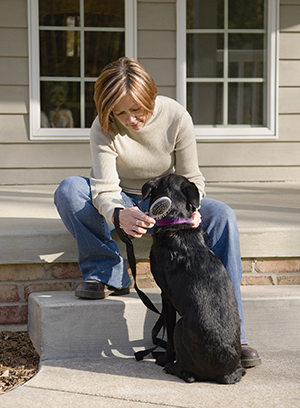Controlling Allergens: Pets
Constant exposure to allergens means constant allergy symptoms. That’s why it's important to control or stay away from the allergens that cause your symptoms. If you are allergic to pets, the tips below may help reduce your exposure.
Pet allergies
Many people think that pet allergy is caused by the fur of cats and dogs. But researchers have found that the major allergens are proteins made by glands in the animals’ skin and mouth, as well as their urine. These proteins are shed in flakes of skin called dander. Allergy-causing proteins in saliva stick to the fur when the animal cleans itself. Urine also contains allergy-causing proteins.
Cats are more likely than dogs to cause allergic reactions. This may be because they lick themselves more. They may also be held more and spend more time indoors. Cats are also often allowed anywhere in a home, including the bedroom. But any furry animal (such as guinea pigs, mice, rats, and birds) can also cause allergies. There is no such thing as a hypoallergenic or allergen-free cat or dog. Hair or fur does not affect the amount of allergen that an animal produces.
If you have allergy symptoms and live in a house with a cat, dog, or other pet, talk with your healthcare provider or with an allergist. They will do an allergy evaluation. Together you can create a treatment plan to help manage your allergy symptoms. You may not need to give up your pet to prevent symptoms.
Controlling animal allergens
The best way to stay away from animal allergens is to not have a pet. And to ensure your house or apartment is free of pests. If you already have a pet and want to keep it, try to reduce your exposure as much as possible. These tips may help:
-
Whenever possible, keep pets outdoors with the right type of weather protection. This won't keep pet dander from getting into your home on clothing or shoes. But it can reduce the amount of dander in the house.
-
Never let pets into your bedroom or on your bed. It can be hard to control pet allergens from getting into the bedroom. You can get allergens on your clothes simply from sitting on your couch. And you'll end up bringing those allergens with you into your bedroom when you get ready for bed.
-
Try to keep pets off sofas, chairs, rugs, and carpeting. Also think about removing carpets. Dust hardwood floors on a regular basis.
-
Use an air-cleaning unit with a HEPA filter, especially in the bedroom.
-
Use filter bags or vacuums designed to reduce allergens.
-
Wash your hands after you touch a pet. Try to keep pets away from your face.
-
Brush and bathe your pet often. Bathing pets helps reduce dander. Bathing also washes other allergens such as dust, mold, and pollen off the animal’s fur. Brush your pets outside, not in the house.
 |
| Brush your pet often to reduce dander. |
Online Medical Reviewer:
Daphne Pierce-Smith RN MSN
Online Medical Reviewer:
Deborah Pedersen MD
Online Medical Reviewer:
Raymond Turley Jr PA-C
Date Last Reviewed:
1/1/2022
© 2000-2024 The StayWell Company, LLC. All rights reserved. This information is not intended as a substitute for professional medical care. Always follow your healthcare professional's instructions.